Question:
I have one more question. I took the motherboard with the LGA1155 socket, which processor should I choose for comfortable work, surfing the Internet and light games?
Valentin, Kopeisk city
Many marketers specializing in IT technologies are surprised to note that the majority of Russian PC users using INTEL products are in no hurry to replace outdated processors with new products that regularly enter the domestic market. In this regard, experts responsibly declare that the point here is not at all in the cost of the favorites of a certain line of CPUs, but in the fact that the average PC user does not see much of a difference between a 2-core Pentium and the same Corei3 CPU. That is why many people do not really understand which processor is better and what new opportunities open up for the average PC user.
In addition, most obsolete “stones” still remain relevant for many configurations personal computers and cope well with office, email applications and work on the Internet, as optimization of an existing software under multi-core environments it passes quite slowly.
In our subjective opinion, many users simply do not have the opportunity to compare the performance of computers with updated version CPUs based on the same platform. We decided to break through the “information vacuum” in this area and review several of the most popular Intel processors CoreI3 and IntelCoreI5.
Getting to know the characteristics and capabilities of these CPU is better just start with dual-core CPUs of the three thousandth series with a design Ivy Bridge.
Core i3-3240
CPU Intel Core The i3-3240 is the oldest and most expensive model in the entire Ivy Bridge family. It runs at 3.4 GHz, which is quite comparable to high-end models that use 4 cores. Despite this clock speed, the i3-3240 has only two cores and only 3 MB of L3 cache. In addition, this processor model, although the most expensive in the line, does not support Turbo Boost technology and a serious graphics core. The younger version of Intel HD Graphics 2500 is integrated into this CPU.
For overclockers, this processor is also not of particular interest, since the ability to increase the multiplier is disabled, although it is possible to control the frequencies of DDR 3 memory. Based on this, we can confidently say that the CPUi3-3240 can only operate at the nominal frequency. Estimated heat dissipation - 55 W. The cost declared by the manufacturer is 138 USD.
To objectively answer the question of how to choose a processor, you cannot limit yourself to the older model from the extensive line of 3,000-series processors. Let's take a closer look at weaker CPUs made on the Ivy Bridge micro-architecture.
Core i3-3225
This device has two cores, each of which is 100 MHz slower than the older model, which is equal to 3.3 GHz. L3 cache and heat dissipation remain unchanged and match the i3-3240's 3MB and 55W ratings. But the graphics accelerator implanted in this CPU model is much more productive. Intel HD Graphics 4000 operates at 1.05 GHz, but has 16 execution units, versus 6 in the Intel HD Graphics 2500 graphics core integrated into the i3-3240. This provides a significant benefit, especially in applications that use 3D graphics and modeling. Declared cost – 134 USD. 
Core i3-3220
The Core i3-3220 CPU is the low-end model with an Ivy Bridge design. It has (by tradition) 2 cores with a clock frequency of 3.3 GHz each and an L3 cache of 3 MB. What makes this device slower is the weak HD Graphics 2500 graphics core with 6 execution units. In addition, the i3-3220 does not support Turbo Boost technology and has a locked multiplier, so it can only operate at the standard frequency. Overclockers have long given up on this model, since it has no chance of overclocking. Heat dissipation is standard - 55 W. The cost declared by the manufacturer is 117 USD. 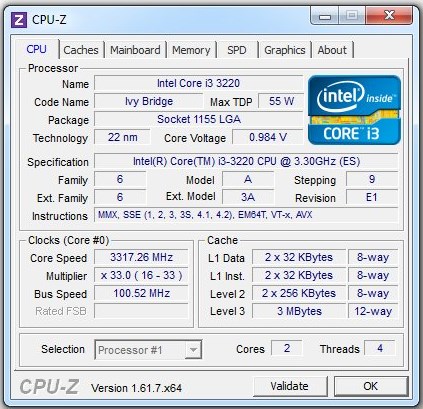
Based on the ratio technical characteristics and cost, the best of the updated Core i3 processors presented in the review, made on the Ivy Bridge microarchitecture, is the Intel Core i3-3225 CPU
Intel strictly adheres to the classification of its CPUs: all iCore 3 processors are dual-core with a 3 MB level 3 cache. Corei5 processors - quad-core, without Hyper-Threading support and L3 cache – 6 MB.
To make it easier to answer the question of most desktop PC users, how to choose the right processor and what characteristics you should pay attention to, we will consider three representatives of the 3 thousandth generation CPUCorei5 of the mid-price segment, made on the same LGA 1155 platform, Ivy Bridge microarchitecture.
Core i5-3570K
The Core i5-3570K is the top product in the three thousandth series, made with Ivy Bridge design. This device has 4 cores with a clock frequency of 3.4 GHz each and a 6 MB level 3 cache. In addition, the CPU of this model has a built-in Intel HD Graphics 4000 graphics core with support for DirectX 11, OpenGL 4.0 and OpenCL 1.1 interfaces. This video accelerator has high performance performance, which is especially noticeable when working with graphics and 3D applications. The heat dissipation level of this CPU is within 77 W. 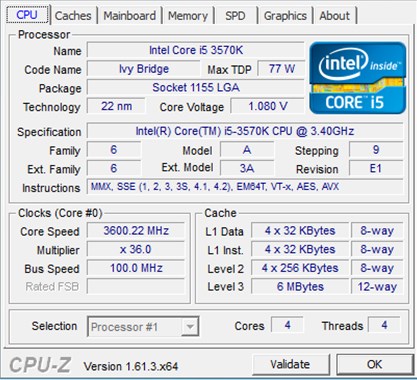
This “stone” is especially interesting for overclockers, thanks to the unlocked multiplier. Given the capabilities of this CPU, the affordable price of 225 USD makes it one of the most popular on the domestic market.
Not sure about your choice? Trust our company! We will select the optimal processor, even if you need to bring it from other regions to Chelyabinsk.
Core i5-3550
This device is exactly like the older CPU model. Traditional 4 cores, L3 at 6 MB. The only difference is the processor clock frequency, which is 3.3 GHz, and the graphics core of the younger version, HD Graphics 2500. It is the graphics that make it less interesting for many users working with graphic programs and 3D modeling. The heat dissipation of the device is 77 W. Recommended cost: 205 USD 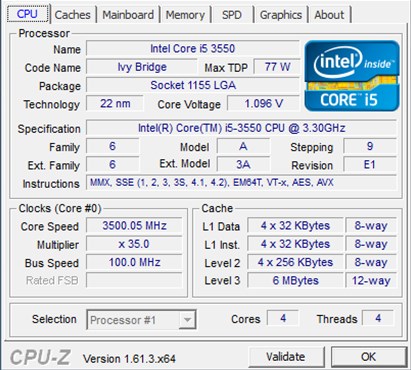
Those wishing to purchase this CPU should weigh the pros and cons, since the cost of this product is the same as the older model, i5-3570, and the clock frequency is 100 MHz lower.
Core i5-3470
The i5-3470 CPU is the penultimate model in the line of devices based on Ivy Bridge architecture. It has 4 cores with a frequency of each 3.2 GHz and L3 equal to 6 MGB. It is the small difference in frequency with older CPUs of this series that will not make a difference for most users, but the cost of 180 USD will be a pleasant bonus.
The integrated graphics core HD Graphics 2500 is less powerful and operates at 1.1 GHz. The absence of the letter “K” in the processor marking makes it uninteresting for overclockers, since this “indicates” that the multiplier is blocked. The heat dissipation remains at 77 W. 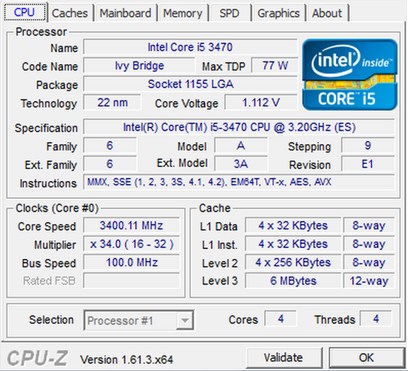
Based on the ratio of characteristics and cost, the best representative among those participating in the review is the IntelCore i5-3570K. It has fairly high performance, has a high-performance graphics core, and has the ability to overclock, at an average cost of 225 USD.
Introduction
Intel's new processors belonging to the Ivy Bridge family have been on the market for several months now, but meanwhile it seems that their popularity is not very high. We have repeatedly noted that compared to their predecessors, they do not look like a significant step forward: their computing performance has increased slightly, and the frequency potential revealed through overclocking has become even worse than that of the previous one. Generation Sandy Bridge. Intel also notes the lack of rush demand for Ivy Bridge: life cycle previous generation of processors, in the production of which an older one is used technological process with 32-nm standards, is being extended and extended, and not the most optimistic forecasts are being made regarding the distribution of new products. More specifically, by the end of this Intel of the Year is going to bring Ivy Bridge's share of desktop processor shipments to only 30 percent, while 60 percent of all CPU shipments will continue to be based on the microarchitecture Sandy Bridge. Does this give us the right not to consider the new Intel processors as another success for the company?
Not at all. The fact is that everything said above applies only to processors for desktop systems. The mobile market segment reacted to the release of Ivy Bridge in a completely different way, because most of the innovations in the new design were made specifically with laptops in mind. Two main advantages of Ivy Bridge over Sandy Bridge: significantly reduced heat dissipation and power consumption, as well as an accelerated graphics core with support for DirectX 11 - in mobile systems are in great demand. Thanks to these advantages, Ivy Bridge not only gave impetus to the release of laptops with a much better combination of consumer characteristics, but also catalyzed the introduction of a new class of ultraportable systems - ultrabooks. The new technological process with 22-nm standards and three-dimensional transistors has made it possible to reduce the size and cost of manufacturing semiconductor crystals, which, naturally, is another argument in favor of the success of the new design.
As a result, only users may be somewhat averse to Ivy Bridge desktop computers, and the dissatisfaction is not associated with any serious shortcomings, but rather with the lack of fundamental positive changes, which, however, no one promised. Do not forget that in Intel’s classification, Ivy Bridge processors belong to the “tick” clock, that is, they represent a simple translation of the old microarchitecture onto new semiconductor rails. However, Intel itself is well aware that fans of desktop systems are somewhat less intrigued by the new generation of processors than their fellow laptop users. Therefore, there is no rush to carry out a full-scale update model range. On this moment in the desktop segment, the new microarchitecture is cultivated only in older quad-core processors of the Core i7 and Core i5 series, and models based on the Ivy Bridge design are adjacent to the familiar Sandy Bridge and are in no hurry to relegate them to the background. A more aggressive introduction of the new microarchitecture is expected only in late autumn, and until then the question of which quad-core Core processors are preferable - the second (two-thousandth series) or third (three-thousandth series) generation - buyers are asked to decide on their own.
Actually, to facilitate the search for an answer to this question, we conducted a special test in which we decided to compare Core i5 processors belonging to the same price category and intended for use within the same LGA 1155 platform, but based on different designs: Ivy Bridge and Sandy Bridge.
Third generation Intel Core i5: detailed introduction
A year and a half ago, with the release of the series Core second generation, Intel introduced a clear classification of processor families, which it adheres to to the present day. According to this classification, the fundamental properties of the Core i5 are a quad-core design without support for Hyper-Threading technology and a 6 MB L3 cache. These features were inherent in the previous generation Sandy Bridge processors, and they are also observed in the new version of the CPU with the Ivy Bridge design.
This means that all Core i5 series processors using the new microarchitecture are very similar to each other. This, to some extent, allows Intel to unify its product output: all of today's Core i5 generations of Ivy Bridge use a completely identical 22-nm semiconductor chip with E1 stepping, consisting of 1.4 billion transistors and having an area of about 160 square meters. mm.
Despite the similarity of all LGA 1155 Core i5 processors in a number of formal characteristics, the differences between them are clearly noticeable. A new technological process with 22-nm standards and three-dimensional (Tri-Gate) transistors allowed Intel to reduce the typical heat dissipation for the new Core i5. If previously Core i5 in LGA 1155 version had a thermal package of 95 W, then for Ivy Bridge this value is reduced to 77 W. However, following the reduction in typical heat dissipation, there was no increase in clock frequencies of the Ivy Bridge processors included in the Core i5 family. The older Core i5s of the previous generation, as well as their today's successors, have nominal clock speeds, not exceeding 3.4 GHz. This means that in general, the performance advantage of the new Core i5 over the old ones is provided only by improvements in the microarchitecture, which, in relation to CPU computing resources, are insignificant even according to the Intel developers themselves.
Speaking about the strengths of the new processor design, first of all you should pay attention to the changes in the graphics core. Third generation Core i5 processors use a new version Intel video accelerator – HD Graphics 2500/4000. She has support software interfaces DirectX 11, OpenGL 4.0 and OpenCL 1.1 and in some cases can offer higher 3D performance and faster encoding of high-definition video to H.264 via Quick Sync technology.
In addition, the Ivy Bridge processor design also contains a number of improvements made in the hardware - memory controllers and PCI Express bus. As a result, systems based on the new third-generation Core i5 processors can fully support video cards using the PCI Express 3.0 graphics bus, and are also capable of clocking DDR3 memory at higher frequencies than their predecessors.
From its first debut to the general public until now, the third-generation Core i5 desktop processor family (that is, Core i5-3000 processors) has remained almost unchanged. Only a couple of intermediate models have been added to it, as a result of which, if we do not take into account economical options with a reduced thermal package, it now consists of five representatives. If we add a pair of Ivy Bridge Core i7 based on the Ivy Bridge microarchitecture to this five, we get a complete desktop line of 22 nm processors in LGA 1155 version:

The table above obviously needs to be supplemented to describe in more detail the functioning of Turbo Boost technology, which allows processors to independently increase their clock frequency if energy and temperature operating conditions allow it. In Ivy Bridge this technology has undergone certain changes, and the new Core i5 processors are capable of auto-overclocking somewhat more aggressively than their predecessors belonging to the Sandy Bridge family. Against the background of minimal improvements in the microarchitecture of computing cores and the lack of progress in frequencies, this is often what can ensure a certain superiority of new products over their predecessors.

The maximum frequency that Core i5 processors are capable of reaching when loading one or two cores exceeds the nominal by 400 MHz. If the load is multi-threaded, then Core i5 generation Ivy Bridge, provided they are in favorable temperature conditions, can raise their frequency by 200 MHz above the nominal value. At the same time, the efficiency of Turbo Boost for all processors under consideration is absolutely the same, and the differences from the previous generation CPUs are a greater increase in frequency when loading two, three and four cores: in the Sandy Bridge generation Core i5, the auto-overclocking limit in such conditions was 100 MHz lower.
Using the readings of the CPU-Z diagnostic program, let’s take a closer look at the representatives of the Core i5 lineup with Ivy Bridge design.
Intel Core i5-3570K
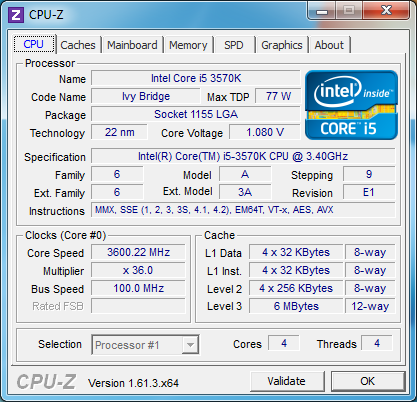
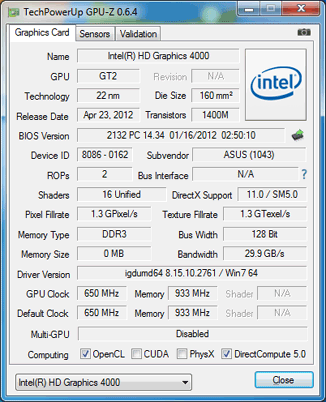
The Core i5-3570K processor is the crown of the whole Core line i5 third generation. It boasts not only the highest clock frequency in the series, but also, unlike all other modifications, it has an important feature, emphasized by the letter “K” at the end of the model number - an unlocked multiplier. This allows Intel, not without reason, to classify the Core i5-3570K as a specialized overclocking offering. Moreover, compared to the older overclocking processor for the LGA 1155 platform, Core i7-3770K, Core i5-3570K looks very tempting thanks to a much more acceptable price for many, which can make this CPU almost the best market offer for enthusiasts.
At the same time, the Core i5-3570K is interesting not only for its predisposition to overclocking. For other users, this model may also be interesting due to the fact that it has a built-in older variation of the graphics core – Intel HD Graphics 4000, which has significantly higher performance than the graphics cores of other members of the Core i5 model range.
Intel Core i5-3570


The same name as the Core i5-3570K, but without the final letter, seems to hint that we are dealing with a neo-overclocking version of the previous processor. So it is: the Core i5-3570 operates at exactly the same clock speeds as its more advanced brother, but does not allow unlimited multiplier variation, which is popular among enthusiasts and advanced users.
However, there is one more “but”. The Core i5-3570 did not include a fast version of the graphics core, so this processor is content with the younger version of Intel HD Graphics 2500, which, as we will show below, is significantly worse in all aspects of performance.
As a result, the Core i5-3570 is more similar to the Core i5-3550 than the Core i5-3570K. For which he has very good reasons. Appearing a little later than the first group of Ivy Bridge representatives, this processor symbolizes a certain development of the family. Having the same recommended price as the model that is one line lower in the table of ranks, it seems to replace the Core i5-3550.
Intel Core i5-3550

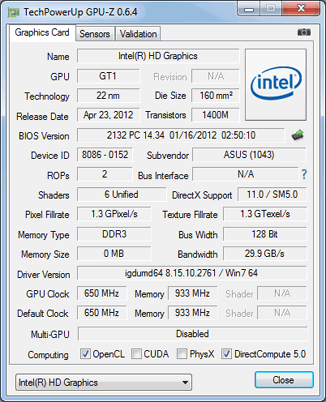
A decreasing model number once again indicates a decrease in computing performance. In this case, the Core i5-3550 is slower than the Core i5-3570 due to its slightly lower clock speed. However, the difference is only 100 MHz, or about 3 percent, so it should not be surprising that both the Core i5-3570 and Core i5-3550 are rated the same by Intel. The manufacturer’s logic is that the Core i5-3570 should gradually displace the Core i5-3550 from store shelves. Therefore, in all other characteristics, except for the clock frequency, both of these CPUs are completely identical.
Intel Core i5-3470
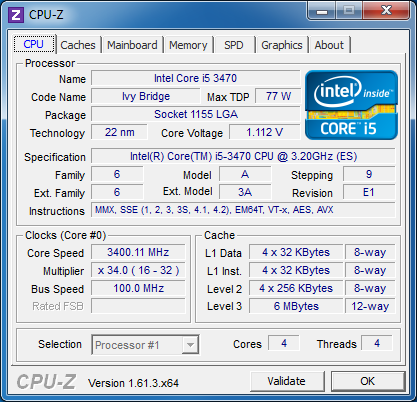
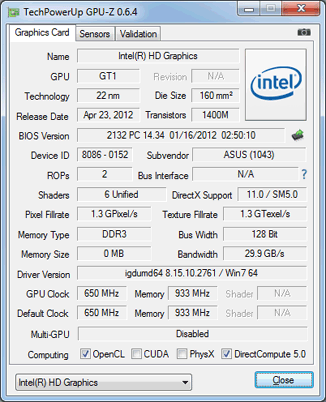
The younger pair of Core i5 processors, based on the new 22nm Ivy Bridge core, have a recommended price below the $200 mark. These processors can be found in stores at similar prices. At the same time, the Core i5-3470 is not much inferior to the older Core i5: all four computing cores are in place, a 6-MB third-level cache and a clock speed of over 3 gigahertz. Intel has chosen a 100-MHz clock frequency step to differentiate modifications in the updated Core i5 series, so expect a significant difference between models in performance in real problems simply nowhere.
However, the Core i5-3470 additionally differs from its older brothers in terms of graphics performance. The HD Graphics 2500 video core operates at a slightly lower frequency: 1.1 GHz versus 1.15 GHz for more expensive processor modifications.
Intel Core i5-3450
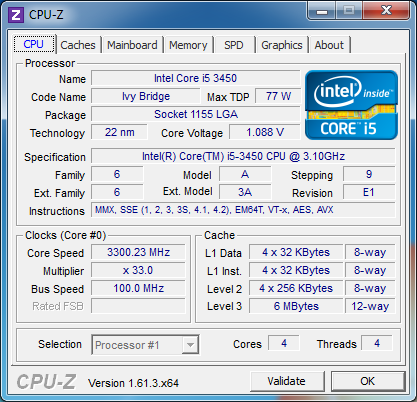

The youngest variation of the third generation Core i5 processor in the Intel hierarchy, the Core i5-3450, like the Core i5-3550, is gradually leaving the market. The Core i5-3450 processor is smoothly replaced by the Core i5-3470 described above, which operates at a slightly higher frequency. There are no other differences between these CPUs.
How we tested
To get a complete breakdown of performance modern Core i5, we have tested in detail all five Core i5 series of three thousand described above. The main competitors for these new products were earlier LGA 1155 processors of a similar class belonging to the Sandy Bridge generation: Core i5-2400 and Core i5-2500K. Their cost makes it possible to contrast these CPUs with the new Core i5 of the three thousandth series: Core i5-2400 has the same recommended price as Core i5-3470 and Core i5-3450; and the Core i5-2500K is sold slightly cheaper than the Core i5-3570K.
In addition, we included in the charts the test results for higher-end processors Core i7-3770K and Core i7-2700K, as well as a processor offered by a competitor, AMD FX-8150. By the way, it is very significant that after the next price reductions, this senior representative of the Bulldozer family costs as much as the cheapest Core i5 of the three thousandth series. That is, AMD no longer harbors any illusions about the possibility of pitting its own eight-core processor against Intel's Core i7 class CPU.
As a result, the test systems included the following software and hardware components:
Processors:
AMD FX-8150 (Zambezi, 8 cores, 3.6-4.2 GHz, 8 MB L3);
Intel Core i5-2400 (Sandy Bridge, 4 cores, 3.1-3.4 GHz, 6 MB L3);
Intel Core i5-2500K (Sandy Bridge, 4 cores, 3.3-3.7 GHz, 6 MB L3);
Intel Core i5-3450 (Ivy Bridge, 4 cores, 3.1-3.5 GHz, 6 MB L3);
Intel Core i5-3470 (Ivy Bridge, 4 cores, 3.2-3.6 GHz, 6 MB L3);
Intel Core i5-3550 (Ivy Bridge, 4 cores, 3.3-3.7 GHz, 6 MB L3);
Intel Core i5-3570 (Ivy Bridge, 4 cores, 3.4-3.8 GHz, 6 MB L3);
Intel Core i5-3570K (Ivy Bridge, 4 cores, 3.4-3.8 GHz, 6 MB L3);
Intel Core i7-2700K (Sandy Bridge, 4 cores + HT, 3.5-3.9 GHz, 8 MB L3);
Intel Core i7-3770K (Ivy Bridge, 4 cores + HT, 3.5-3.9 GHz, 8 MB L3).
CPU cooler: NZXT Havik 140;
Motherboards:
ASUS Crosshair V Formula (Socket AM3+, AMD 990FX + SB950);
ASUS P8Z77-V Deluxe (LGA1155, Intel Z77 Express).
Memory: 2 x 4 GB, DDR3-1866 SDRAM, 9-11-9-27 (Kingston KHX1866C9D3K2/8GX).
Graphic cards:
AMD Radeon HD 6570 (1 GB/128-bit GDDR5, 650/4000 MHz);
NVIDIA GeForce GTX 680 (2 GB/256-bit GDDR5, 1006/6008 MHz).
Hard drive: Intel SSD 520 240 GB (SSDSC2CW240A3K5).
Power supply: Corsair AX1200i (80 Plus Platinum, 1200 W).
Operating system: Microsoft Windows 7 SP1 Ultimate x64.
Drivers:
AMD Catalyst 12.8 Driver;
AMD Chipset Driver 12.8;
Intel Chipset Driver 9.3.0.1019;
Intel Graphics Media Accelerator Driver 15.26.12.2761;
Intel Management Engine Driver 8.1.0.1248;
Intel Rapid Storage Technology 11.2.0.1006;
NVIDIA GeForce 301.42 Driver.
When testing a system based on AMD processor FX-8150, patches operating system KB2645594 and KB2646060 were installed.
The NVIDIA GeForce GTX 680 video card was used to test the speed of processors in a system with discrete graphics, while the AMD Radeon HD 6570 was used as a benchmark when studying the performance of integrated graphics.
The Intel Core i5-3570 processor did not participate in testing systems equipped with discrete graphics, since in terms of computing performance it is completely identical to the Intel Core i5-3570K, operating at the same clock speeds.
Computational performance
Overall Performance
To evaluate processor performance in common tasks, we traditionally use the Bapco SYSmark 2012 test, which simulates user work in common modern office programs and applications for creating and processing digital content. The idea of the test is very simple: it produces a single metric characterizing the weighted average speed of the computer.
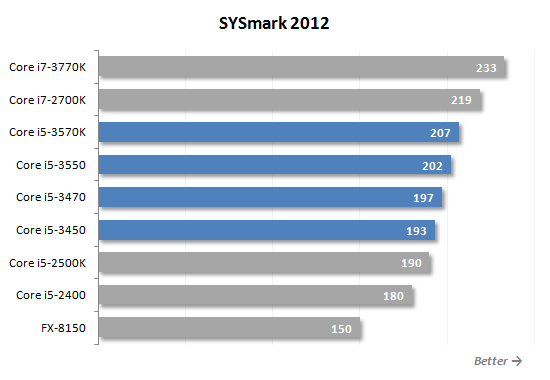
In general, Core i5 processors belonging to the three thousandth series demonstrate quite expected performance. They are faster than the previous generation Core i5, and the Core i5-2500K processor, which is almost the fastest Core i5 with a Sandy Bridge design, is inferior in performance to even the youngest of the new products, the Core i5-3450. However, at the same time, fresh Core i5s are not able to reach the Core i7, due to the lack of Hyper-Threading technology in them.
A deeper understanding of SYSmark 2012 results can be provided by familiarizing yourself with the performance scores obtained in various system usage scenarios. The Office Productivity scenario simulates typical office work: preparing text, processing spreadsheets, working with by email and visiting Internet sites. The script uses the following set of applications: ABBYY FineReader Pro 10.0, Adobe Acrobat Pro 9 Adobe Flash Player 10.1 Microsoft Excel 2010, Microsoft Internet Explorer 9, Microsoft Outlook 2010, Microsoft PowerPoint 2010, Microsoft Word 2010 and WinZip Pro 14.5.

The Media Creation scenario simulates the creation of a commercial using pre-shot digital images and videos. For this purpose, popular Adobe packages are used: Photoshop CS5 Extended, Premiere Pro CS5 and After Effects CS5.

Web Development is a scenario within which the creation of a website is modeled. Applications used: Adobe Photoshop CS5 Extended, Adobe Premiere Pro CS5, Adobe Dreamweaver CS5, Mozilla Firefox 3.6.8 and Microsoft Internet Explorer 9.
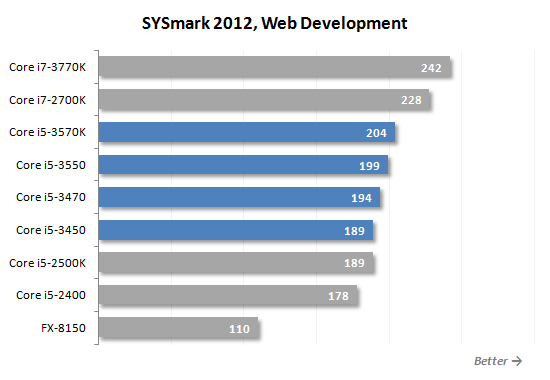
The Data/Financial Analysis scenario is dedicated to statistical analysis and forecasting of market trends, which is performed in Microsoft Excel 2010.

The 3D Modeling script is all about creating three-dimensional objects and rendering static and dynamic scenes using Adobe Photoshop CS5 Extended, Autodesk 3ds Max 2011, Autodesk AutoCAD 2011 and Google SketchUp Pro 8.

The last scenario, System Management, involves creating backups and installing software and updates. There are several different Mozilla versions Firefox Installer and WinZip Pro 14.5.

In most scenarios, we are faced with a typical picture where the Core i5 3000 series is faster than its predecessors, but inferior to any Core i7, both based on the Ivy Bridge microarchitecture and Sandy Bridge. However, there are also cases of processor behavior that is not entirely typical. Thus, in the Media Creation scenario, the Core i5-3570K processor manages to outperform the Core i7-2700K; when using 3D modeling packages, the eight-core AMD FX-8150 performs unexpectedly well; and in the System Management scenario, which generates mainly a single-threaded load, the previous generation Core i5-2500K processor almost catches up with the performance of the fresh Core i5-3470.
Gaming Performance
As you know, the performance of platforms equipped with high-performance processors in the vast majority of modern games is determined by the power of the graphics subsystem. That is why, when testing processors, we try to conduct tests in such a way as to remove the load from the video card as much as possible: the most processor-dependent games are selected, and tests are carried out without turning on anti-aliasing and with settings that are not at the highest resolutions. That is, the results obtained make it possible to evaluate not so much the level of fps achievable in systems with modern video cards, but how well processors perform with a gaming load in principle. Therefore, based on the results presented, it is quite possible to speculate about how processors will behave in the future, when faster options for graphics accelerators appear on the market.

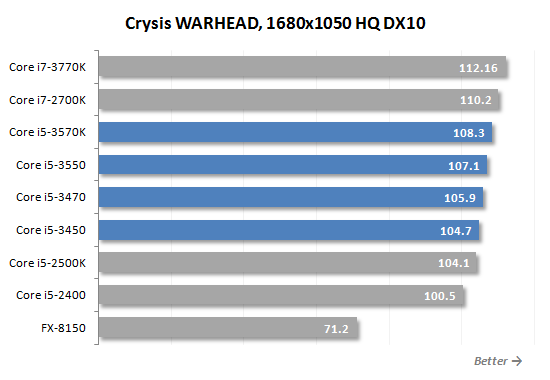



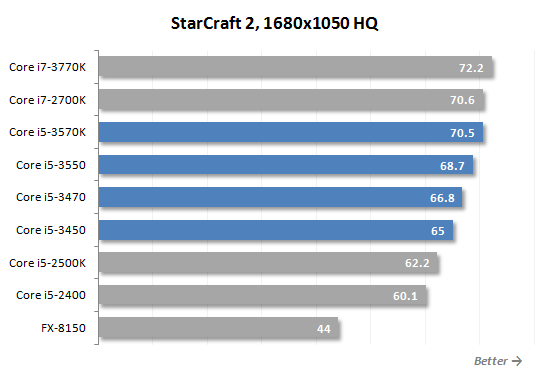
In our numerous previous tests, we have repeatedly characterized the Core i5 family of processors as being well suited for gamers. We do not intend to abandon this position now. IN gaming applications Core i5s are strong thanks to their efficient microarchitecture, quad-core design, and high clock speeds. Their lack of support for Hyper-Threading technology can play a good role in games that are poorly optimized for multi-threading. However, the number of such games among the current ones is decreasing every day, which we see from the results presented. The Core i7, based on the Ivy Bridge design, ranks higher than the internally similar Core i5 in all charts. As a result, the gaming performance of the 3,000-series Core i5 is at a completely expected level: these processors are definitely better Core i5 2000 series, and sometimes even capable of competing with the Core i7-2700K. At the same time, we note that AMD’s senior processor cannot compete with modern Intel offerings: its lag in gaming performance can, without any exaggeration, be called catastrophic.
In addition to the gaming tests, we also present the results of the synthetic benchmark Futuremark 3DMark 11, launched with the Performance profile.
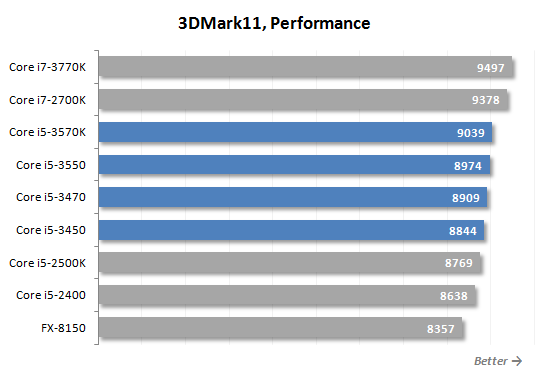

The synthetic test Futuremark 3DMark 11 does not show anything fundamentally new either. The performance of the third-generation Core i5 falls exactly between the Core i5 with the previous design and any Core i7 processors that have support for Hyper-Threading technology and slightly higher clock speeds.
Tests in applications
To measure the speed of processors when compressing information, we use the WinRAR archiver, with which we archive a folder with various files with a total volume of 1.1 GB with the maximum compression ratio.
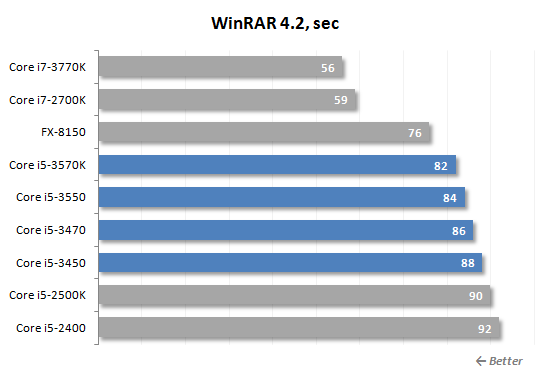
IN latest versions The WinRAR archiver has significantly improved support for multithreading, so that now the archiving speed has become seriously dependent on the number of available CPU computing cores. Accordingly, the Core i7 processors, enhanced by Hyper-Threading technology, and the eight-core AMD FX-8150 processor demonstrate the best performance here. As for the Core i5 series, everything is as always with it. Core i5 with Ivy Bridge design is definitely better than the old ones, and the advantage of the new products over the old ones is about 7 percent for models with the same nominal frequency.
Processor performance under cryptographic load is measured by the built-in test of the popular TrueCrypt utility, which uses AES-Twofish-Serpent “triple” encryption. It should be noted that this program not only is it capable of efficiently loading any number of cores with work, but also supports a specialized set of AES instructions.

Everything is as usual, only the FX-8150 processor is again at the top of the chart. It is helped in this by the ability to execute eight computational threads simultaneously and the good speed of execution of integer and bit operations. As for the Core i5 of the three thousandth series, they are again unconditionally superior to their predecessors. Moreover, the difference in CPU performance with the same declared nominal frequency is quite significant and is about 15 percent in favor of new products with Ivy Bridge microarchitecture.
With the release of the eighth version of the popular scientific computing package Wolfram Mathematica, we decided to return it to the list of used tests. To evaluate the performance of systems, it uses the MathematicaMark8 benchmark built into this system.

Wolfram Mathematica has traditionally been one of the applications that struggles with Hyper-Threading technology. That is why in the above diagram the first position is occupied by the Core i5-3570K. And the results of other Core i5 3000 series are quite good. All these processors not only outperform their predecessors, but also leave behind the older Core i7 with Sandy Bridge microarchitecture.
We measure performance in Adobe Photoshop CS6 using our own test, a creative reworking of the Retouch Artists Photoshop Speed Test, which involves typical processing of four 24-megapixel images taken with a digital camera.
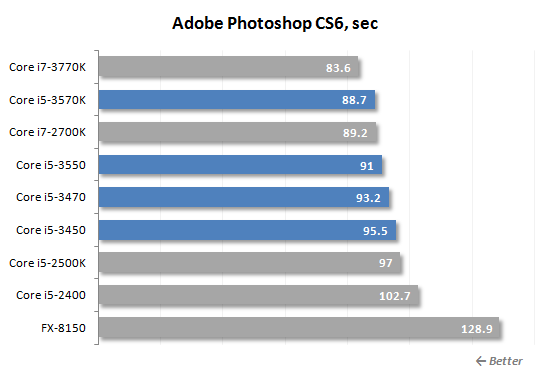
The new Ivy Bridge microarchitecture provides approximately 6% superiority in clock speed Core frequency The third generation i5 is superior to its earlier siblings. If we compare processors with the same cost, then the carriers of the new microarchitecture find themselves in an even more advantageous position, winning over 10 percent of performance from the Core i5 of the 2000 series.
Performance in Adobe Premiere Pro CS6 is tested by measuring the rendering time in the H.264 Blu-Ray format of a project containing HDV 1080p25 video with various effects applied.

Nonlinear video editing is a highly parallelizable task, so the new Core i5 with Ivy Bridge design is not able to reach the Core i7-2700K. But they outperform their classmate predecessors using the Sandy Bridge microarchitecture by about 10 percent (when comparing models with the same clock frequency).
To measure the speed of video transcoding into the H.264 format, x264 HD Benchmark 5.0 is used, based on measuring the processing time of source video in MPEG-2 format, recorded in 1080p resolution with a stream of 20 Mbps. It should be noted that the results of this test are of great practical importance, since the x264 codec used in it underlies numerous popular transcoding utilities, for example, HandBrake, MeGUI, VirtualDub, etc.
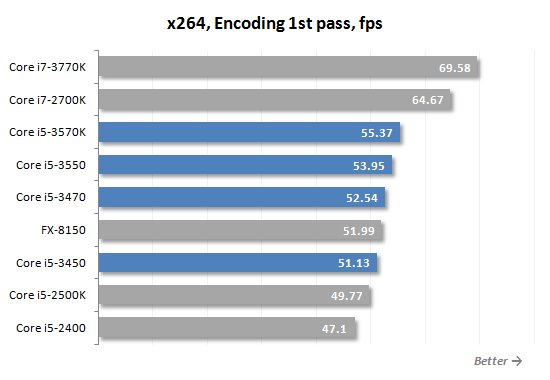

The picture when transcoding high-resolution video content is quite familiar. The advantages of the Ivy Bridge microarchitecture result in approximately 8-10 percent superiority of the new Core i5 over the old ones. What’s unusual is the high result of the eight-core FX-8150, which even outperforms the Core i5-3570K in the second encoding pass.
At the request of our readers, the used set of applications has been supplemented with another benchmark that shows the speed of working with high-resolution video content - SVPmark3. This is a specialized test of system performance when working with the SmoothVideo Project package, aimed at improving the smoothness of video by adding new frames to the video sequence containing intermediate positions of objects. The numbers shown in the diagram are the result of a benchmark on real FullHD video fragments without involving the power of the graphics card in the calculations.

The diagram is very similar to the results of the second pass of transcoding with the x264 codec. This clearly suggests that most tasks associated with processing high-definition video content create approximately the same computational load.
We measure computing performance and rendering speed in Autodesk 3ds max 2011 using the specialized test SPECapc for 3ds Max 2011.
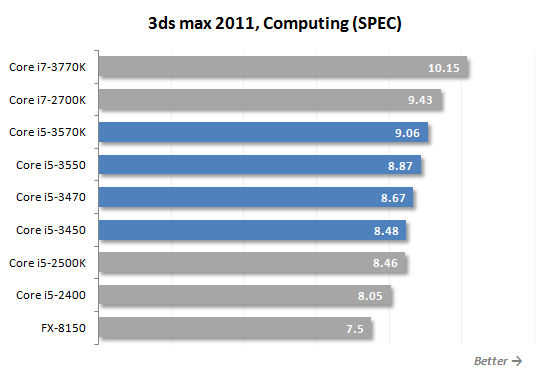
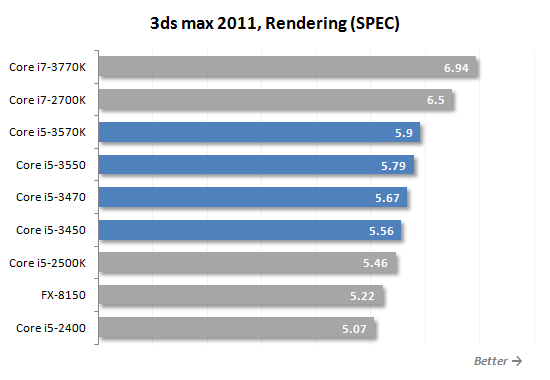
To be honest, nothing new can be said about the performance observed in the final rendering. The distribution of results can be called standard.
Testing the final rendering speed in Maxon Cinema 4D is performed using a specialized test called Cinebench 11.5.

The Cinebench results chart doesn't show anything new either. The new Core i5 of the three thousandth series once again turns out to be noticeably better than their predecessors. Even the youngest of them, Core i5-3450, confidently outperforms Core i5-2500K.
Energy consumption
One of the main advantages of the 22-nm process technology used to produce Ivy Bridge generation processors is the reduced heat generation and power consumption of semiconductor crystals. This is also reflected in the official specifications of the third generation Core i5: they are equipped with a 77-watt thermal package rather than a 95-watt one, as before. So the superiority of the new Core i5 over its predecessors in terms of efficiency is beyond doubt. But what is the scale of this gain in practice? Should the efficiency of the 3,000-series Core i5 series be considered a serious competitive advantage?
To answer these questions, we conducted special testing. The new Corsair AX1200i digital power supply we use in our test system allows us to monitor the electrical power consumed and output, which is what we use for our measurements. The following graphs, unless otherwise noted, show the total system consumption (without monitor), measured “after” the power supply and representing the sum of the power consumption of all components involved in the system. The efficiency of the power supply itself is not taken into account in this case. During measurements, the load on the processors was created by the 64-bit version of the LinX 0.6.4-AVX utility. In addition, to properly estimate idle power consumption, we activated turbo mode and all available energy-saving technologies: C1E, C6 and Enhanced Intel SpeedStep.

When idle, systems with all processors participating in the tests show approximately the same power consumption. Of course, it is not completely identical, there are differences at the level of tenths of a watt, but we decided not to transfer them to the diagram, since such an insignificant difference is more likely related to measurement error than to the observed physical processes. In addition, in conditions of similar processor consumption values, the efficiency and settings of the motherboard power converter begin to have a serious impact on the overall power consumption. Therefore, if you are really concerned about the amount of power consumption at rest, you should first look for motherboards with the most efficient power converter, and, as our results show, any processor from among the LGA 1155-compatible models can be suitable.

A single-threaded load, in which processors with turbo mode increase the frequency to maximum values, leads to noticeable differences in consumption. The first thing that catches your eye is the completely immodest appetites of the AMD FX-8150. As for LGA 1155 CPU models, those based on 22 nm semiconductor crystals are indeed noticeably more economical. The difference in consumption between quad-core Ivy Bridge and Sandy Bridge, operating at the same clock speed, is about 4-5 W.

The full multi-threaded compute load exacerbates the consumption differences. The system, equipped with third-generation Core i5 processors, is more economical than a similar platform with processors of the previous design of about 18 W. This perfectly correlates with the difference in theoretical heat dissipation figures declared for their processors by Intel. Thus, in terms of performance per watt, Ivy Bridge processors have no equal among desktop CPUs.
GPU performance
Considering modern processors for the LGA 1155 platform, attention should also be paid to the graphics cores built into them, which with the introduction of the Ivy Bridge microarchitecture have become faster and more advanced in terms of available capabilities. However, at the same time, Intel prefers to install in its processors for the desktop segment a stripped-down version of the video core with the number of actuators reduced from 16 to 6. In fact, full graphics are present only in Core i7 and Core i5-3570K processors. Most of the 3,000-series Core i5 desktops will obviously be quite weak in 3D graphics applications. However, it is quite likely that even the existing reduced graphics power will satisfy a certain number of users who do not intend to consider the integrated graphics as a 3D video accelerator.
We decided to start testing integrated graphics with the 3DMark Vantage test. Results obtained in different versions of 3DMark are a very popular metric for assessing the weighted average gaming performance of video cards. The choice of the Vantage version is due to the fact that it uses DirectX version 10, which is supported by all video accelerators tested, including the graphics of Core processors with Sandy Bridge design. Note that in addition to full set processors of the Core i5 family, working with their integrated graphics cores, we included in the tests and performance indicators of a system based on Core i5-3570K with discrete graphics card Radeon HD 6570. This configuration will serve as a kind of reference point for us, allowing us to imagine the place of Intel graphics cores HD Graphics 2500 and HD Graphics 4000 in the world of discrete video accelerators.
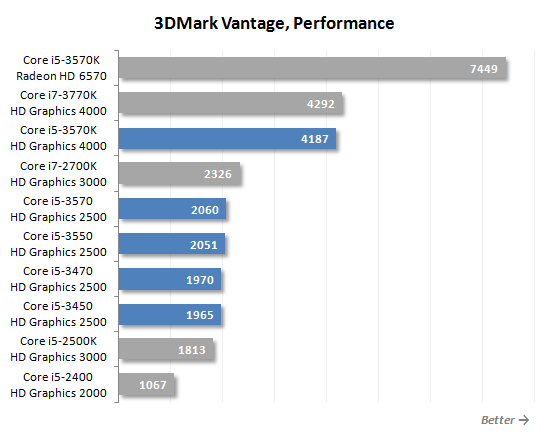
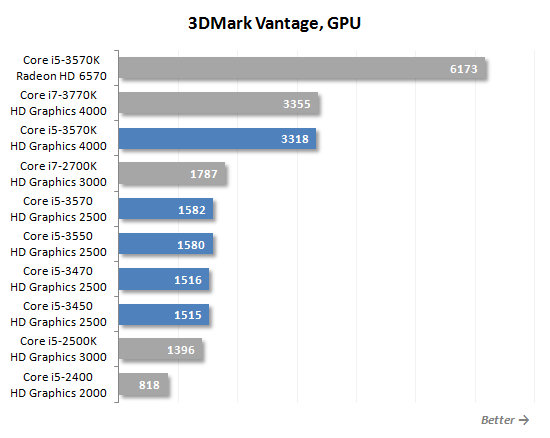
The HD Graphics 2500 graphics core installed by Intel in most of its desktop processors is similar in 3D performance to the HD Graphics 3000. But the older version of Intel graphics from Ivy Bridge processors, HD Graphics 4000, looks like a huge step forward, its performance is more than doubled exceeds the speed of the best embedded core of the previous generation. However, any of the available Intel HD Graphics options cannot yet be called having acceptable 3D performance by desktop standards. For example, the Radeon HD 6570 video card, which belongs to the lower price segment and costs about $60-70, can offer significantly better performance.
In addition to the synthetic 3DMark Vantage, we also ran several tests in real gaming applications. In them, we used low graphics quality settings and a resolution of 1650x1080, which we currently consider to be the minimum of interest to desktop users.


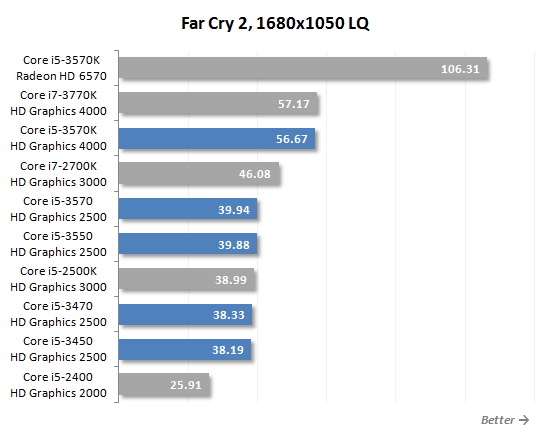

In general, the games show approximately the same picture. Built-in older version of Core i5-3570K graphics accelerator provides an average number of frames per second at a fairly good level (for an integrated solution). However, the Core i5-3570K remains the only third-generation Core i5 processor whose video core is capable of delivering acceptable graphics performance, which, with some relaxations in picture quality, may be enough to comfortably play a significant number of current games. All other CPUs in this class, which use the HD Graphics 2500 accelerator with a reduced number of execution units, produce almost half the speed, which is clearly not enough by modern standards.
The advantage of the HD Graphics 4000 graphics core over the built-in accelerator of the previous generation HD Graphics 3000 varies widely and averages about 90 percent. The previous flagship integrated solution can easily be compared with the younger version of graphics from Ivy Bridge, HD Graphics 2500, which is installed in most Core i5 desktop processors of the three thousandth series. As for the previous version of the commonly used graphics core, HD Graphics 2000, its performance now looks extremely low; in games it lags behind the same HD Graphics 2500 by an average of 50-60 percent.
In other words, the 3D performance of the graphics core of Core i5 processors has indeed increased significantly, but compared to the number of frames that the Radeon HD 6570 accelerator is capable of producing, all this seems like fuss. Even the HD Graphics 4000 accelerator built into the Core i5-3570K is not very good alternative low-level desktop 3D accelerators, while the more common version of Intel graphics, one might say, is generally not applicable for most games.
However, not all users consider the video cores built into processors as 3D gaming accelerators. A significant portion of consumers are interested in HD Graphics 4000 and HD Graphics 2500 due to their media capabilities, which simply do not have alternatives in the lower price category. Here, first of all, we mean Quick Sync technology, designed for fast hardware video encoding into the AVC/H.264 format, the second version of which is implemented in processors of the Ivy Bridge family. Because in the new graphic Intel cores promises a significant increase in transcoding speed, we separately tested the functioning of Quick Sync.
During practical tests We measured the transcoding completion time of one 40-minute episode of a popular TV series encoded in 1080p H.264 at 10 Mbps for viewing on an Apple iPad2 (H.264, 1280x720, 3Mbps). For the tests, we used the Cyberlink Media Espresso 6.5.2830 utility, which supports Quick Sync technology.

The situation here is radically different from what was observed in the games. If previously Intel did not differentiate Quick Sync in processors with different versions graphics core, now everything has changed. This technology in HD Graphics 4000 and HD Graphics 2500 operates at approximately twice the speed. Moreover, conventional Core i5 processors of the three thousand series, in which the HD Graphics 2500 core is installed, transcode high-resolution video via Quick Sync with approximately the same performance as their predecessors. Progress in performance is visible only in the results of the Core i5-3570K, which has an “advanced” HD Graphics 4000 graphics core.
Overclocking Core i5 processors belonging to the Ivy Bridge generation can proceed according to two fundamentally different scenarios. The first of them concerns overclocking the Core i5-3570K processor, which was initially aimed at overclocking. This CPU has an unlocked multiplier, and increasing its frequency above the nominal values is carried out according to a typical algorithm for the LGA 1155 platform: by increasing the multiplication factor, we raise the processor frequency and, if necessary, achieve stability by applying increased voltage to the CPU and improving its cooling.
Without raising the supply voltage, our copy of the Core i5-3570K processor overclocked to 4.4 GHz. All that was required to ensure stability in this mode was simply switching the motherboard's Load-Line Calibration feature to High.
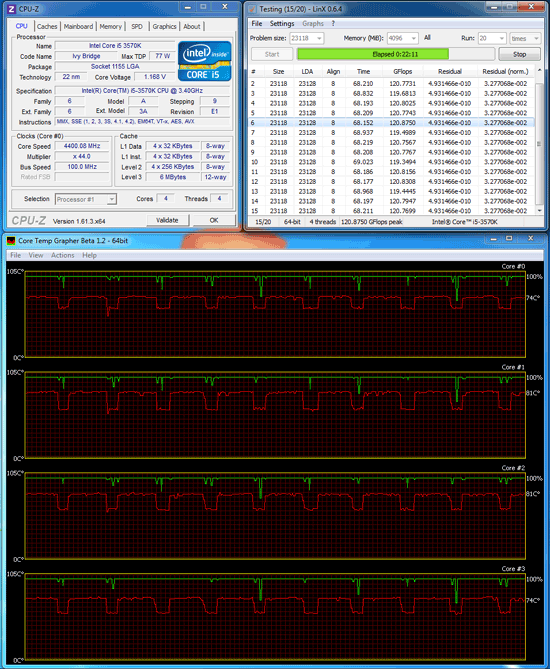
An additional increase in the processor supply voltage to 1.25 V made it possible to achieve stable operation at a higher frequency - 4.6 GHz.
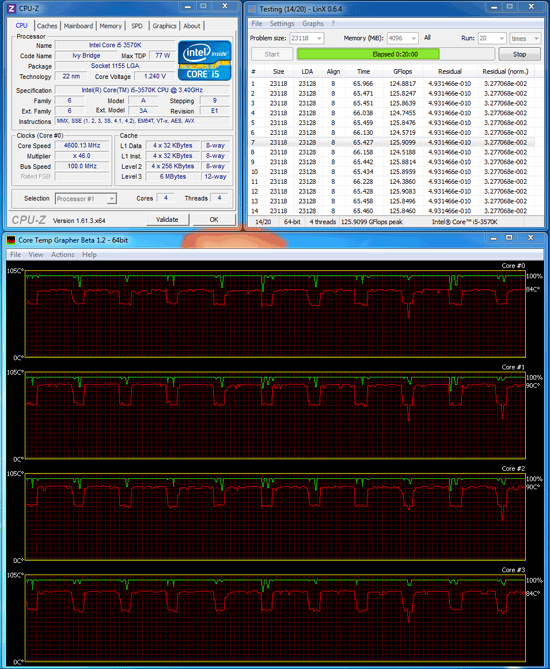
This is a quite typical result for Ivy Bridge generation CPUs. Such processors usually overclock a little worse than Sandy Bridge. The reason is believed to lie in the reduction in the area of the semiconductor processor chip that followed the introduction of 22-nm production technology, raising the question of the need to increase the heat flux density during cooling. At the same time, the thermal interface used by Intel inside processors, as well as the commonly used methods of removing heat from the surface of the processor cover, do not help solve this problem.
However, be that as it may, overclocking to 4.6 GHz is a very good result, especially if you take into account the fact that Ivy Bridge processors at the same clock frequency as Sandy Bridge produce approximately 10 percent better performance due to their microarchitectural improvements.
The second overclocking scenario concerns the remaining Core i5 processors, which do not have a free multiplier. Although the LGA 1155 platform has an extremely negative attitude towards increasing the frequency of the base clock generator, and loses stability even when the generating frequency is set 5 percent higher than the nominal value, it is still possible to overclock Core i5 processors that are not related to the K-series. The fact is that Intel allows you to increase their multiplier to a limited extent, increasing it by no more than 4 units above the nominal value.
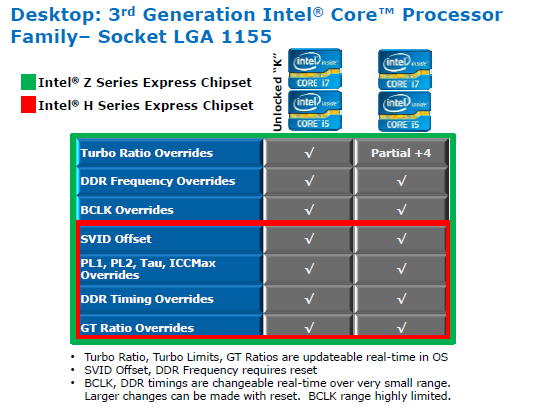
Considering that the Turbo Boost technology remains operational, which for Core i5 with Ivy Bridge design allows for 200 MHz overclocking even when all processor cores are loaded, the clock frequency can generally be “increased” by 600 MHz above the standard value. In other words, the Core i5-3570 can be overclocked to 4.0 GHz, the Core i5-3550 to 3.9 GHz, the Core i5-3470 to 3.8 GHz, and the Core i5-3450 to 3.7 GHz. This we have successfully confirmed during our practical experiments.
Core i5-3570:
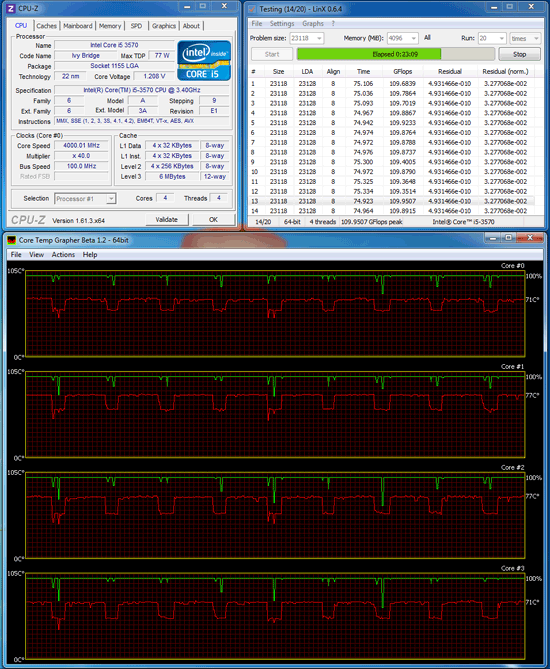
Core i5-3550:

Core i5-3470:

Core i5-3450:
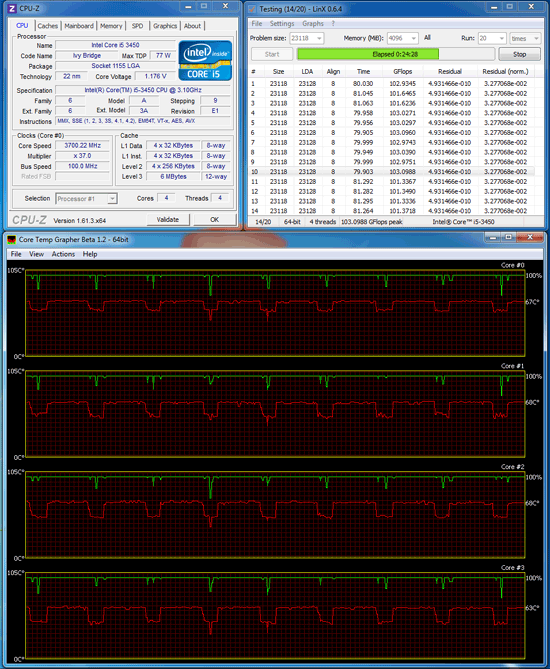
It must be said that such limited overclocking is even easier than with the Core i5-3570K processor. A not so significant increase in clock frequency does not entail stability problems even when using the rated supply voltage. Therefore, most likely, the only thing required to overclock Ivy Bridge processors of the Core i5 line, not related to the K-series, is to change the multiplier value in Motherboard BIOS fees. The result achieved in this case, although it cannot be called a record, will most likely be quite satisfactory for the vast majority of inexperienced users.
We have already said more than once that the Ivy Bridge microarchitecture has become a successful evolutionary update of Intel processors. 22nm semiconductor manufacturing technology and numerous microarchitectural improvements have made the new products both faster and more cost-effective. This applies to any Ivy Bridge in general and to the 3,000-series Core i5 desktop processors discussed in this review in particular. Comparing the new line of Core i5 processors with what we had a year ago, it is not difficult to notice a whole bunch of significant improvements.
Firstly, the new Core i5, based on the Ivy Bridge design, has become more productive than its predecessors. Despite the fact that Intel has not resorted to increasing clock speeds, the advantage of new products is about 10-15 percent. Even the slowest third-generation Core i5 desktop processor, the Core i5-3450, outperforms the Core i5-2500K in most tests. And the older representatives of the new line can sometimes compete with higher-class processors, Core i7, based on the Sandy Bridge microarchitecture.
Secondly, the new Core i5 has become noticeably more economical. Their thermal package is set at 77 Watt, and this is reflected in practice. Under any load, computers using Core i5 with Ivy Bridge design consume several watts less than similar systems using Sandy Bridge CPUs. Moreover, with the maximum computing load, the gain can reach almost two dozen watts, and this is a very significant saving by modern standards.
Thirdly, the new processors have a significantly improved graphics core. The junior version of the graphics core of Ivy Bridge processors works at least as well as the HD Graphics 3000 from the older second-generation Core processors, and besides, supporting DirectX 11, it has more modern capabilities. As for the flagship integrated accelerator HD Graphics 4000, which is used in Core processor i5-3570K, then it even allows you to get quite acceptable frame rates in fairly modern games, albeit with significant relaxations in the quality settings.
The only controversial point that we noticed with the third-generation Core i5 is its slightly lower overclocking potential than that of Sandy Bridge-class processors. However, this drawback manifests itself only in the only overclocker Core models i5-3570K, where the change in the multiplication factor is not artificially limited from above, and moreover, it is fully compensated by the higher specific performance developed by the Ivy Bridge microarchitecture.
In other words, we don’t see any reason why, when choosing a mid-class processor for the LGA 1155 platform, preference should be given to “oldies” using semiconductor crystals of the Sandy Bridge generation. Moreover, the prices set by Intel for more advanced modifications of the Core i5 are quite humane and close to the cost of aging processors of the previous generation.
Quad-core processors of the Ivy Bridge family are firmly on the shelves of all computer stores, so the time has come to expand our knowledge about them, hitherto limited only two top overclocking models Core i5 and i7. Moreover, younger models are of greater practical interest for two reasons. Firstly, they are cheaper, and at times noticeable: savings can be 1000-1500 rubles, which is quite comparable, for example, with the price difference between the Radeon HD 6670 and HD 7750 or HD 7770 and HD 6930, that is, this difference is very relevant for a budget-conscious gamer (let’s ignore for now the issue of the need to purchase a Core i5 or higher in this case - a person may have interests other than gaming at the same time). Secondly, the usefulness of purchasing a representative of the 3x70K line is greatly reduced by the increased heat flow (due to a decrease in the crystal area). Thus, overclockers, quite possibly, will continue to take a closer look at the “oldies” Core i5-2500K and i7-2600K, whose “air” overclocking is somewhat simpler, and there is no need for everyone else to pay extra for unlocked multipliers. But there are no longer any incentives to purchase “regular” Sandy Bridges: the younger Ivy Bridges cost about the same, but in normal mode they consume less energy and, at formally the same frequencies, operate somewhat faster due to improvements in Turbo Boost technology. Even if you plan to overclock a little (and purchase a board on a chipset that allows this), do not forget that the so-called. "Limited Unlocked Core" in the third Generation Core has not gone away, i.e. you can “throw on” +400 MHz on younger processor models, but it’s difficult to get ≈5 GHz due to deteriorated heat dissipation even on older ones.
In general, to summarize, the younger Core i5 and i7 models do not pretend to be the most popular processors, since they are somewhat expensive from the point of view of the “regular” user (usually limited to processors priced up to $200), but, of course, they are doomed to greater popularity than their top-end counterparts. Therefore, the need to test them is obvious, and that is what we will do today.
Test bench configuration
| CPU | Core i5-3450 | Core i5-3550 | Core i5-3570K | Core i7-3770 | Core i7-3770K |
| Kernel name | Ivy Bridge QC | Ivy Bridge QC | Ivy Bridge QC | Ivy Bridge QC | Ivy Bridge QC |
| Production technology | 22 nm | 22 nm | 22 nm | 22 nm | 22 nm |
| Core frequency (std/max), GHz | 3,1/3,5 | 3,3/3,7 | 3,4/3,8 | 3,4/3,9 | 3,5/3,9 |
| 31 | 33 | 34 | 34 | 35 | |
| How Turbo Boost works | 4-4-3-2 | 4-4-3-2 | 4-4-3-2 | 5-5-4-3 | 4-4-3-2 |
| 4/4 | 4/4 | 4/4 | 4/8 | 4/8 | |
| L1 cache, I/D, KB | 32/32 | 32/32 | 32/32 | 32/32 | 32/32 |
| L2 cache, KB | 4×256 | 4×256 | 4×256 | 4×256 | 4×256 |
| L3 cache, MiB | 6 | 6 | 6 | 8 | 8 |
| UnCore frequency, GHz | 3,1 | 3,3 | 3,4 | 3,4 | 3,5 |
| RAM | 2×DDR3-1600 | 2×DDR3-1600 | 2×DDR3-1600 | 2×DDR3-1600 | 2×DDR3-1600 |
| Video core | GMA HD 2500 | GMA HD 2500 | GMA HD 4000 | GMA HD 4000 | GMA HD 4000 |
| Socket | LGA1155 | LGA1155 | LGA1155 | LGA1155 | LGA1155 |
| TDP | 77 W | 77 W | 77 W | 77 W | 77 W |
| Price | N/A() | $250 () | $284 () | $368 () | $431 () |
This is what the entire Ivy Bridge line looks like today, with the exception of energy-efficient models. There are more of the latter than before, but the number of conventional processors has decreased slightly: at the launch of the Core i5-2000 there were four such processors, and in the 3000 line there are three left. Over time, their number will probably grow, but it is unlikely to equal the Sandy Bridge assortment. Let us remind you that over the past year and a half since the start, 9 Core i5 and 3 Core i7 have already accumulated, for which new line answers with three and two models, respectively. But there have been slightly more S- and T-modifications from the very beginning, i.e. the trend is clearly visible: since Intel now manages to “shove” even a Core i7 into 45 W, it would be strange not to take advantage of this. Moreover, what distinguishes the S-variants from the “regular” models is now not 30, but only 12 W. In general, the focus is on efficiency.
The most interesting, perhaps, will be the results of 3770 and 3770K. As you can see, the leadership of the second processor in terms of nominal clock frequency does not mean anything - in reality, these devices will most likely operate at equal frequencies at the same times. If this assumption is confirmed, this will be the final nail in the coffin of the idea of buying a 3770K for normal operation. In the last generation, things were a little different: the Core i7-2700K had the highest clock speeds in the family. Another argument against the older “regular” Core i7-2600 was the GMA HD 2000 video core, not 3000 (as in 2600K and 2700K). And now in normal mode there should be no differences between 3770 and 3770K, and absolutely all desktop Core i7s have received GMA HD 4000. That is, the formal additional 100 MHz of the nominal frequency is just a nice bow (to make it more pleasant for buyers of the top model), and it is not without reason that both processors have the same number. But on the floor below everything is the same: the Core i5-3570K actually has a slightly higher frequency than the 3550, and even the GMA HD 4000 is the only one (at the moment) among all desktop Core i5s, so there are just a few justifications here different numbers.
| CPU | Core 2 Duo E8600 | Core 2 Quad Q9650 | Core i5-750 | Core i7-860 | Core i7-920 |
| Kernel name | Wolfdale | Yorkfield | Lynnfield | Lynnfield | Bloomfield |
| Production technology | 45 nm | 45 nm | 45 nm | 45 nm | 45 nm |
| Core frequency (std/max), GHz | 3,33 | 3,0 | 2,66/3,2 | 2,8/3,46 | 2,66/2,93 |
| Starting multiplication factor | 10 | 9 | 20 | 21 | 20 |
| How Turbo Boost works | — | — | 4-4-1-1 | 5-4-1-1 | 2-1-1-1 |
| Number of cores/threads | 2/2 | 4/4 | 4/4 | 4/8 | 4/8 |
| L1 cache, I/D, KB | 32/32 | 32/32 | 32/32 | 32/32 | 32/32 |
| L2 cache, KB | 6144 | 2×6144 | 4×256 | 4×256 | 4×256 |
| L3 cache, MiB | — | — | 8 | 8 | 8 |
| UnCore frequency, GHz | — | — | 2,66 | 2,8 | 2,13 |
| RAM | — | — | 2×DDR3-1333 | 2×DDR3-1333 | 3×DDR3-1066 |
| Socket | LGA775 | LGA775 | LGA1156 | LGA1156 | LGA1366 |
| TDP | 65 W | 95 W | 95 W | 95 W | 130 W |
| Price | N/A() | N/A() | N/A() | N/A() | N/A() |
Who should we compare processors with? For simplicity, we decided to arrange a kind of express testing, since the K-family was also compared with other competitors of a similar level last time. But we will still go a little beyond the Ivy Bridge family, taking five “oldies” for comparison. Core 2 Duo E8600 and Core 2 Quad Q9650 - best processors for the LGA775 platform (not counting extreme models), which remained the most popular until 2009-2010. Core i5-750 and Core i7-860 are the two most interesting models for LGA1156 in the second half of 2009 (in 2010 they were actually replaced by 760 and 870, but the difference in performance between them and their predecessors is small). And the “people's” solution for the early LGA1366, as well as the first mass-produced (relatively) available Core i7 - 920. Again - later, for the same money, Intel offered more quick solutions, but this started already in 2010. And we are more interested in the period 2008-2009 for one simple reason: about three years have passed since then, so the temptation to change the computers of “then” may already arise. Naturally, the most impatient enthusiasts may have already done this some time ago, but they are a minority among users. And those who were in no hurry to replace the old Core 2 Quad with Sandy Bridge will very likely now consider the transition to Ivy Bridge as a potentially useful event. So let’s evaluate how useful it is in practice. For those who fundamentally disagree with our approach, we traditionally recommend using a pivot table and comparing anything with anything :)
| Motherboard | RAM | |
| LGA1155 | Biostar TH67XE(H67) | |
| LGA1366 | Intel DX58SO2(X58) | 12 GB 3x1066; 8-8-8-19 |
| LGA775 | ASUS Maximus Extreme (X38) | Corsair Vengeance CMZ8GX3M2A1600C9B (2×1333; 9-9-9-24) |
| LGA1156 | ASUS P7H55-M Pro(H55) | Corsair Vengeance CMZ8GX3M2A1600C9B (2×1333; 9-9-9-24) |
Testing
Traditionally, we divide all tests into a number of groups and show on diagrams the average result for a group of tests/applications (you can familiarize yourself with the testing methodology in detail in a separate article). The results in the diagrams are given in points; the performance of the reference test system from the 2011 sample site is taken as 100 points. It is based on the processor AMD Athlon II X4 620, but the amount of memory (8 GB) and video card (NVIDIA GeForce GTX 570 1280 MB by Palit) are standard for all tests of the “main line” and can only be changed within the framework of special studies. Those who are interested in more detailed information are again traditionally invited to download table in Microsoft Excel format, in which all results are presented both converted into points and in “natural” form.
Interactive work in 3D packages
As you can see, the efficiency of all 45-nanometer Intel processors is approximately equal, so some differences can only arise due to extensive improvements, such as frequency or cache memory capacity. But Sandy Bridge raised the bar by about 20-25 percent, and Ivy Bridge did not lose this advantage - with the ensuing result. However, based on the results, it is obvious that for interactive work, it may very well make sense to purchase one of the dual-core Core i3s for LGA1155 (or wait a little for similar models on Ivy Bridge), since additional computation threads are unnecessary here - a couple will definitely be enough. But there is no such thing as too much money :)
Final rendering of 3D scenes
What's most interesting here? The fact that the younger modern Core i5-3450 turned out to be slightly faster than the Core i7 of three or four years ago. Yes, the processors are already old, but generally speaking they belong to a higher class (and more expensive, in particular). And this is despite the significant increase from Hyper-Threading technology, which allows the Core i7 to always outperform the Core i5 of the same generation! The progress since Core2 is also very significant - 3770/3770K is almost twice as fast as the Q9650. At the time of its announcement in August 2008, the latter, by the way, cost $530 wholesale, i.e. much more expensive than any current processor for LGA1155 (and in general, close price range It’s been almost a year and a half since the six-core Core i7 “registered”. Well, there’s no point in commenting on the results of the E8600 - it seems to us that those who really need high performance In multi-threaded applications, we parted ways with Core 2 Duo a long time ago.
Packing and Unpacking
But in archiving tests, the benefit of multithreading is not very great, the reason for which has already been stated more than once: only one test out of four is able to use it fully, and for two, one thread is enough. Therefore, the entire increase can only be achieved through improved architecture and extensive methods. Of course, it exists, but it is not nearly as impressive as in the previous or subsequent cases.
Audio encoding
The situation is similar to rendering, with one small exception: the Core i5-3450 managed to outperform only the Core i7-920, but not faster models. However, taking into account the love of this test for increasing multithreading in any way, this should be assessed as a very good result. Intel's first (albeit modernized) quad-core processors are naturally not competitors to modern ones, even if the latter do not have NT. And if available, there is again an almost twofold difference.
Compilation
As we already said, Intel solution reducing the cache capacity of the second generation Core i5 severely clipped their wings in compiler tests. This also applies to the third generation, so only the best of the modern Core i5s only managed to catch up with the worst of the Core i7s of all time. But at least he caught up with him. But the Core i7 retained its 8 MiB of cache memory, so they easily moved ahead, and they again outperformed one of the best Core 2 Quads by almost twice.
Mathematical and engineering calculations
And again a low-flow group, although for the second year in a row it has been affected by the architectural improvements of both “bridges”. Accordingly, even the Core i5-3450 significantly outperformed all the old guys, which is good. What’s bad is that we are not talking about any double gains under such a load in any “old-new” processor pair.
Raster graphics
Again, a mixed group, where there is an increase both from an increase in the number of cores and from NT, but in both cases it is not fundamental. The architecture has a stronger influence, so again, on the one hand, the new processors are noticeably faster than the old ones, but on the other, the advantage never reaches twofold.
Vector graphics
Even half the dose of Core 2 Duo is enough here, and anything can be improved only architecturally - or with higher frequencies. Ivy Bridge has both, allowing them to be the fastest. But not as fast as in multi-threaded tests - here, at best, there is a one and a half times superiority.
Video encoding
But in video processing it again begins to tend to double (if we discard the Core 2 Duo, however, as it seems to us, there are illusions about dual core processors No one has powered under such a load for five years). Another thing is more curious - already marked a tendency for the efficiency of Hyper-Threading to decrease as the Core architecture improves: if in the first generation the i7 outperformed similar i5s by about 10%, now the difference has halved. Which, in general, is understandable: the more “densely” the available resources are loaded by one thread, the more difficult it is to allocate them for the second.
Office software
What is curious is that the seemingly very conservative office group accelerated no worse than the others (and, compared to some programs, even better). As we have already said, this doesn’t make much sense when comparing processors of the class under consideration, but it’s still a trifle, but nice.
Java
Again a multi-threaded group, and again an almost twofold advantage of the new Core i7 over the old Core 2 Quad. Well, the fact that the new Core i5 is capable of overtaking the old Core i7 is also no longer a secret. In general, progress has not gone away - the whole question is in assessing its pace.
Games
But in games, as has been said a hundred times, processor performance is not the determining factor, since the video system comes first. But, as we see, you shouldn’t neglect the processor either - even the cheapest modern Core i5 is almost one and a half times faster than the best Core 2 Duo and is 25% faster than best Core 2 Quad. In general, it makes sense for gamers to simultaneously acquire new card thinking about switching from LGA775 is far from the worst idea. The main thing is not to spoil it with the desire to acquire the most fast processor under LGA1155 - this is no longer very justified. And for those who have managed to migrate to LGA1366 or LGA1156 over the past years, it seems to us that they don’t have to fuss, because it won’t pay off.
Total
The first thing you should pay attention to: except for overclocking, the Core i7-3770K is not needed for anything else. The difference in the nominal frequency, however, has some effect, but +0.5% performance is not at all something worth paying more than 10% of the price for. Is it even worth paying extra for a Core i7? This is also an interesting question. As you can see, the difference between the i7 and i5 families is indeed gradually narrowing (following the decrease in the relative efficiency of Hyper-Threading), which could not be prevented even by cutting the cache memory of the latter last year. But here everyone chooses according to their capabilities and needs: in some classes of problems the difference between these families is still large, but in others (also as before) it is not worth paying attention to.
Is it worth switching to a new platform from one of the old ones? No less complex and dependent on many factors issues. It is clear that those who have enough power of the computer they are using will not be affected by it - they will use it until it burns out. Or - until an irresistible desire arises to buy something new, but here calculations and calculations no longer make sense :) In other cases, options are possible. As you can see, in general, even the slowest processor of the new Core i5 family is about one and a half times faster than the best for LGA775. Together with other advantages of the new motherboards This leads us to the clear conclusion that an upgrade within LGA775 is less justified than a transition to a new platform. For LGA1156 and LGA1366, everything is not so simple - after all, we looked at junior processors for these platforms, which are still only one and a half times at most behind the quad-core Ivy Bridge, and there are also older ones. So if you have such a processor, then you don’t have to rush until the next fundamental update of Intel’s microarchitecture (or some miracle from AMD). If not, then in all likelihood it will be possible to purchase an old platform for a reasonable price only on the secondary market - buy new Core The i7-960 is certainly not worth the price of a set of Core i5-3550 and a good board (and somewhere such a ratio is observed in those stores where the “oldies” are still on the shelves). Well, or, of course, you can always play around with overclocking, since old platforms are more tolerant of this than new ones.
In general, in this case it all depends on what point of view the potential buyer (if, we repeat, he is a potential buyer) adheres to. Optimistic - new processors are slightly faster and more economical than the old ones. Pessimistic - they are too much A little faster, and money is never wasted. The final choice, as usual, will depend on what outweighs :)




